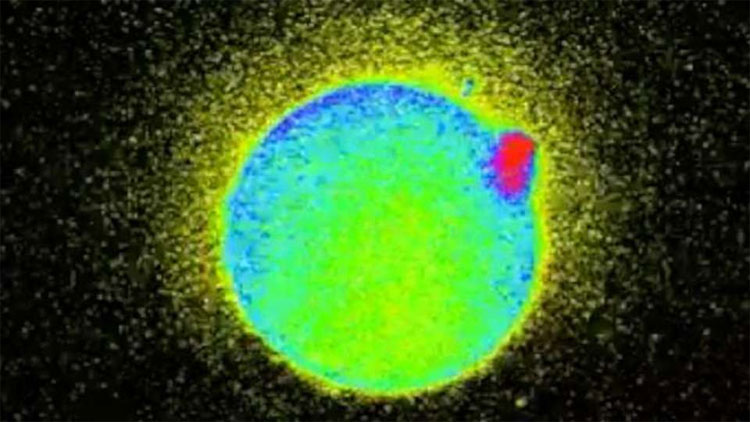The first time the zinc beam was shot at the time the sperm touched the egg
At exactly the moment a sperm touches an egg, billions of zinc atoms have fired from the surface of the egg. Using fluorescence microscopy, scientists found zinc rays emitting light.
The discovery that human eggs undergo this process can lead to new ways for doctors, to identify viable eggs for IVF (IVF).

The strange moment of zinc rays that scientists have captured during the study.
"This is remarkable , " Teresa Woodruff, one of the two authors of the paper, is explaining on the Scientific Report.
"We have only discovered zinc rays in mice five years ago, and the image of zinc rays emitted from human eggs is really spectacular. All biological processes start at the time of fertilization," he said. but we do not know about events happening in people ".
To get these images, scientists pumped in an egg an enzyme released by sperm when they touched the egg.

The eggs light up when encountering sperm enzymes, images taken at a time when life begins.The egg on the upper right and the lower left fruit shows a brighter signal of health.(Photo: Northwestern University).
They were not allowed to use actual sperm due to human research restrictions under US law, but previous studies using mice 's eggs and sperm showed the same thing happened. Enzymes from sperm cause increased calcium in the egg and produce zinc atoms.
These zinc atoms are then attached to small molecules that in turn emit light in fluorescence microscopy experiments. This means that when sperm touches eggs and eggs releases billions of zinc atoms, it can even be a small ray of light.
This is the first time researchers have determined that this process not only occurs in other mammals but also during human fertilization.

A fluorescent ray captures the moment when sperm enzymes enter the egg.(Photo: Northwestern University).
In embryonic development, the amount of zinc contained in an egg may be important in the development of a newly fertilized embryo. With the discovery that zinc rays emitted from eggs are a direct sign of their zinc levels, they can give doctors a new way of choosing fruit. The best eggs with the highest chance of survival are used for IVF.
"At present, no tool can tell us about the quality of the eggs," said Dr. Eve Feinberg, co-author of the paper.
"Often we do not know whether eggs or embryos are really feasible until we see results that happen later. This is why IVF results are unpredictable. If we can see Prior to the quality of eggs, it will help increase fertilization rate more successfully, avoid a lot of sadness and achieve a much faster pregnancy effect. "
- The benefits of zinc for the body
- The time of sperm reaches the highest quality
- Scientists have calculated the time the Moon touched the Earth
- It turns out that it is the egg that determines which sperm to choose to conceive
- 6 weird and interesting facts about 'sperm'
- 10 things you don't know about sperm
- Zinc helps children with infections recover quickly
- How long does sperm live outside the body?
- Sperm are produced like?
- Interesting surprises you never knew about sperm
- This is why eating oysters helps increase the physiological power of men
- The untold story of the sperm race: Stupid, comfortable, not as much as possible
 Green tea cleans teeth better than mouthwash?
Green tea cleans teeth better than mouthwash? Death kiss: This is why you should not let anyone kiss your baby's lips
Death kiss: This is why you should not let anyone kiss your baby's lips What is salmonellosis?
What is salmonellosis? Caution should be exercised when using aloe vera through eating and drinking
Caution should be exercised when using aloe vera through eating and drinking